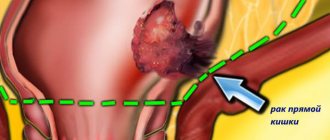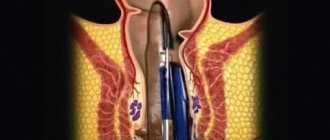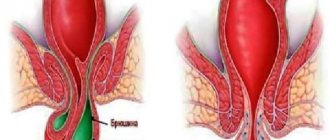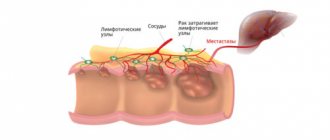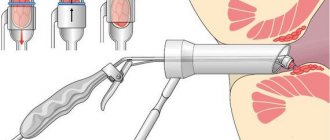In this article we will look at how to understand that you have hemorrhoids. When ominous symptoms appear, people do not rush to the hospital, embarrassed to seek help from specialists. How to treat hemorrhoids, why is it important to see a doctor if you have a disease, and not use folk remedies at home? Every person should know the answers to the questions. With limited mobility, poor nutrition, hemorrhoids can affect anyone. If it is treated as soon as the first signs appear, it can be managed without serious complications.
A large proportion of humanity suffers from such an unpleasant disease as hemorrhoids. Some go to the hospital amid the first symptoms of the disease, while others endure and wait, and then still run to the doctor. Mostly people who lead a sedentary life suffer from this intestinal pathology. Thus, it turns out that absolutely every office worker or someone who does not pay due attention to sports and physical activity can get sick with it. Next, we’ll look at how to understand that you have hemorrhoids, and what kind of disease they are.
A little about the disease itself
All people have hemorrhoids, which look like folds that appear on the surface of the rectal mucosa. Together with the muscles, they do not allow feces to leave the intestines before the bowel movement process. Hemorrhoids are varicose veins of this intestine.
This dilation of the veins in the anus (hemorrhoidal inflammation) is a pathology associated with blood stagnation and very strong tension. This leads to disruption of the normal position of hemorrhoidal folds. They move down to the anus along with the intestinal mucosa. Because of this, improper blood flow of the folds occurs, they in turn begin to grow, appearing outside the anus.
How can you tell if a person has developed hemorrhoids or a fissure? Factors that provoke the appearance of such formations include:
- The influence of alcoholic beverages and smoking.
- Excess weight and problematic bowel movements.
- Maintaining a sedentary lifestyle.
- Regular lifting of heavy objects.
- Passion for anal sex.
- Pregnancy and childbirth.
The disease can also occur as a consequence of poor nutrition, for example, among lovers of spicy and spicy foods. Pregnancy can also be a provoking factor.
How does the disease begin and what are its first symptoms and signs?
Let's figure out how to understand that you have hemorrhoids? Many people only realize they have a bowel problem when they see blood on paper or on their underwear. But this is only one of the few signs of pathology. How can you tell if hemorrhoids have developed? Its symptoms are usually:
- The presence of pain during movement, sitting and during defecation.
- Feeling the bumps with your hands, sometimes a sharp pain occurs.
- The appearance of unpleasant sensations near the anus, burning or itching may occur. How else can you understand that hemorrhoids have appeared?
- The presence of heaviness in the abdomen along with the sensation of a foreign body in the anus.
- The appearance of blood in the feces or bleeding during bowel movements.
This symptomatology complicates life, as the person feels insecure and uncomfortable. How to understand that hemorrhoids have appeared? To accurately determine intestinal pathology, you need to consult a doctor, namely a proctologist. A doctor can easily diagnose the disease based on pronounced symptoms and instrumental research methods.
Outpatient stage of examination
At an outpatient appointment, the proctologist finds out the patient’s complaints and medical history. This is important for a more accurate diagnosis. Then a visual inspection and digital examination are performed. The patient should come to the appointment prepared, with a clean intestine, so that the doctor can painlessly detect all pathological changes.
After the manipulations, treatment and additional instrumental methods are prescribed to clarify the diagnosis. The doctor chooses specific methods of further examination depending on the picture revealed during external examination and rectal palpation. These can be endoscopic methods:
- anoscopy;
- fibrosigmoidoscopy;
- colonoscopy.
X-ray examination is also used:
- irrigoscopy, -graphy;
- CT scan;
- MRI;
- virtual CT or MRI.
Any technique has its advantages and disadvantages. Regardless of the chosen method, the examination allows you to identify various intestinal pathologies, including hemorrhoids in the early stages of development.
Visual inspection
The diagnosis of hemorrhoidal disease begins with an external examination. External enlarged venous bumps are visible to the naked eye. You can evaluate their size, skin condition, color, integrity, and the presence of thrombosis. The nodes can be single or located around the anus.
How to understand that hemorrhoids have come out?
Dilation of the veins in the anus is a disease during which inflammatory processes occur with thrombosis in the blood supply of the rectum. The patient experiences an unpleasant sensation in the anal area, as well as during bowel movements. But with such a problem, many are in no hurry to consult a doctor and try to somehow determine on their own whether it is hemorrhoids or not.
Patients forget that some intestinal pathologies may have symptoms similar to hemorrhoids. And the correct diagnosis can only be made by a doctor, and then after a thorough examination. The main factor in the appearance of the disease is the occurrence of inflammation, which is located under the skin in the perineum, in the areas of the vascular plexus.
The disease is divided into:
- External type, when inflammation affects almost all the plexuses of blood vessels that are located under the skin of the perineum.
- The internal type is a pathological process that begins in the walls of the rectum.
But, regardless of the type of pathology, areas of the rectum always become inflamed, venous blood flow is disrupted, and at the same time muscle tissue is depleted. How to understand what stage of hemorrhoids is described below.
Determining the stage of the disease
In addition to the form, hemorrhoidal disease also differs in its stages. Depending on the stage, its symptoms, complexity and duration of treatment, as well as the need for surgical assistance are diagnosed. At each stage, in the area of the anus and rectal area, certain changes generally occur that affect the general symptoms and pain of the disease.
First stage
Also known as the initial stage of development of the disease, it is characterized by less pain or absence of pain. Since at this stage the bumps are just beginning to form, there is also no bleeding, burning, or problems with bowel movements. At this stage, discomfort, as a rule, is minimal and is limited only to itching, unpleasant sensations in the anal area, bloating, but this is precisely what makes this stage dangerous. It can be extremely difficult to identify hemorrhoids at the first stage, as a result of which the disease goes unnoticed and actively progresses.
Second stage
Characterized by more severe symptoms. The nodes have already formed on the external or internal part of the anal passage, the disease is accompanied by severe pain, burning and stinging in the anus, blood loss and loss of hemorrhoids are possible. Defecation at this stage is complicated by the location of the nodes and hardening of the feces, which only injures and irritates the walls of the colon and sphincter. It is preferable to begin treatment of hemorrhoids at stage 1-2, since its further development will only aggravate the situation and can provoke the development of serious pathologies.
Third stage
Called the progressive or complicated stage, it is characterized by severe pain during bowel movements, tension and pinching of hemorrhoidal cones. The nodes on the outside begin to become inflamed and engorged with blood, and later they fall out of the anus after the exercise. At this stage, heavy blood loss is observed, disrupting general blood circulation, leading to weakness, lethargy and weakening of the body. Due to bleeding, the onset of infectious processes is possible. The acute complicated stage of hemorrhoid disease involves surgical intervention or long-term outpatient treatment.
Fourth stage
It is considered the most severe and aggravated stage of the disease, the patient suffers from incredible pain. Hemorrhoids fall out and bleed heavily, sitting on a flat, hard surface becomes impossible, every movement leads to the formation of tears and microcracks in the walls of the colon. At this stage, heavy blood loss is observed, which is often accompanied by general malaise, weakening of the body, lightheadedness, and soon leads to the development of anemia. At this stage there is a high risk to the patient’s life. Therefore, stage 4 hemorrhoids must be treated without delay and exclusively through surgical removal.
Stages
At the initial stage, hemorrhoids, as a rule, are rarely a concern. Therefore, most patients do not notice it. Concern usually begins when a burning sensation with itching and swelling is noted near the anus. It happens that after a bowel movement, slight bleeding begins. If such signs are not paid attention to and are not treated, then the disease develops into the second stage, in which it becomes difficult to have a bowel movement, as severe pain occurs. Patients try to put off going to the toilet as long as possible, which will cause increased pressure in the nodes and turn out to be a source of inflammation.
How to understand the stage of hemorrhoids correctly? At the third and fourth stages of this disease, the nodes fall out. At first, you will be able to return them back with the help of your hands, but then they will stop being pulled inward on their own. They will fall out not only after a visit to the toilet, but even with little effort, for example, coughing or sneezing.
How to determine the stage of hemorrhoids
The stage of the disease is determined by the symptoms and condition of the hemorrhoids. In the first stage they are barely enlarged. In the second, the nodes are felt and fall out during intense exercise or after defecation. In the third stage, hemorrhoids fall out with a slight load, but for now they are set manually. In the fourth stage, the nodes can no longer be set - this is external hemorrhoids.
When diagnosing the degree of hemorrhoids, the doctor performs a digital examination if the nodes have not yet come out. A finger is inserted into the anus, the nodes and the degree of expansion of the intestine are felt, and the contents are examined - blood, pus. Anoscopy is performed using a special device after a cleansing enema. If it is difficult to make a diagnosis, sigmoidoscopy is recommended.
Treatment methods
After making the correct diagnosis, the doctor decides what treatment to prescribe to the patient. But at all stages, treatment is carried out, which allows you to relieve the symptoms of the disease, that is, reduce pain by stopping bleeding. When hemorrhoids belong to the first or second stage, it can be cured provided that conservative therapy is used, that is, medications that relieve discomfort and prevent complications, as well as contribute to the postoperative rehabilitation of patients. The best results are obtained by the joint use of medicinal drugs for external or internal use.
If after a week no positive changes are observed, you should definitely undergo a re-examination by your proctologist, who should suggest another method of treatment.
When hemorrhoids are in the second or third stage, it will be impossible to cure it with medications alone; in this case, minimally invasive methods are used, which, unlike operating rooms, are less traumatic for patients; patients spend less time in the hospital and recover faster. These include:
- Application of infrared radiation. With the help of it, the doctor acts on hemorrhoids with high temperature, cauterizing the vessels. Such an operation will not require anesthesia (except in cases where this area is highly sensitive in patients) and is the least traumatic. Coagulation is also possible using laser beams.
- Use of sclerotherapy. The patient is injected into the area of hemorrhoids with a special substance that glues the walls of blood vessels. It is usually injected into no more than two nodes so that patients do not develop pain. The next session is carried out two weeks later.
- Performing ligation of hemorrhoids with latex rings. This technique is most often used for the treatment of hemorrhoids in the elderly who have diseases that complicate the course of treatment. Against this background, a small latex ring is placed on the node, gradually squeezing it, which leads to its necrosis and rejection. Bleeding does not occur in this case, since the stump is covered with a ring. Subsequently, healthy connective tissue is formed in its place. The procedure is considered virtually painless, with little trauma.
- Application of cryotherapy. With this method, hemorrhoidal nodes are exposed to low temperatures, then after thawing they die, the resulting wounds heal over time, and connective tissue is formed in place of the node. The operation is performed under local anesthesia.
All minimally invasive treatment methods are used only if there is no exacerbation of hemorrhoids. When hemorrhoids enter the acute stage, it is necessary, first of all, to eliminate inflammation and reduce bleeding.
Treatment of hemorrhoids
First degree hemorrhoids are easily treated with conservative therapy. It is possible to use local drugs in combination with systemic ones. The more advanced the disease, the more difficult it is to treat. In the final stages, they resort to surgery because medications are not effective enough. The doctor determines the degree of development of the disease and prescribes appropriate treatment to relieve the patient of the disease.
How to treat hemorrhoids at an early stage
Hemorrhoids of the first stage are relatively easy to treat. For this purpose, complex drug therapy is carried out. Chronic internal hemorrhoids of the 1st degree require similar regular maintenance therapy to reach the stage of remission. Treatment includes:
- Preparations to increase venous tone and blood microcirculation. These are Detralex, Proctosedyl and analogues. The course of treatment is long - over 3 months.
- Local antiseptic antipruritic and hemostatic drugs. Rectal suppositories are most often used - Relief, Proctosan, Nigepan. Ointments are used - Aurobin, Nefluan.
- Together, anti-inflammatory drugs for local use are prescribed - Levomekol.
- To improve digestion and simplify bowel movements, laxatives are prescribed - Regulax, Duphalac.
- For severe pain, use Lidocaine.
Along with medication, minimally invasive therapy is carried out, which is especially effective for complications. This:
- disarterization of nodes;
- infrared coagulation;
- doping with latex rings.
In later stages
The acute version of the disease in the later stages is much more difficult to treat. Here, doping with latex rings is possible, but this procedure has contraindications - paraproctitis, thrombosis - and is ineffective. Drug therapy does not help here. Local treatment is possible, but creams will not bring relief, and placing rectal suppositories is already difficult if it is external hemorrhoids. At the third and fourth stages of the disease, surgical intervention is practiced.
Hemorrhoidectomy - excision of nodes using a scalpel and electrocoagulation. In modern medicine, ultrasonic scissors are used. The intervention is performed under general anesthesia and takes less than an hour. Scars form at the site of the nodes. After surgery, local antiseptic suppositories and ointments are prescribed to promote healing.
After childbirth
Usually, in the last months of pregnancy, women are forced to lead a sedentary life, which is not conducive to health. During childbirth, the muscles in the perineum tend to tense, stretching the cavernous bodies of the rectum. With severe stretching of the muscles in the perineum, weakening of the anal sphincter and prolapse of the nodes are likely.
How to understand that hemorrhoids appeared after childbirth? Often women who have given birth confuse the symptoms of hemorrhoids with the consequences of childbirth and do not immediately consult a doctor, thereby provoking the development of the disease.
How can you tell if an illness is internal?
Now let's find out how to understand whether hemorrhoids are internal or external. Under the mucous membranes of the lower region of the anal canal there is a localization of hemorrhoidal internal nodes. As a rule, they do not fall out, and there is no pain or bleeding. The patient can only feel an unpleasant sensation in the anal canal, as if there is a foreign object there. But this is only at the first stage of the disease, since the formations are still small in size. Only a doctor can determine whether a person has hemorrhoids or not.
Under the influence of negative factors, the nodes fill with blood and increase in size. Blood clots appear and veins lose elasticity and strength. Self-therapy can only worsen the disease and contribute to the development of a chronic form. And a specialist will help you understand that a person has hemorrhoids without the procedure of feeling the back door. You should definitely go to a proctologist if bleeding occurs or the patient feels discomfort in the rectum.
Hemorrhoids in the postpartum period
Hemorrhoids in women often occur during the postpartum period, which is understandable. This is due to several factors:
- circulatory disorders in the pelvis;
- fetal pressure on the rectum;
- increased secretion of progesterone, which negatively affects the tone of veins and blood vessels.
Diagnosis of hemorrhoids is carried out only by a proctologist. It is not advisable to contact a gynecologist and listen to his advice in this matter. This is the mistake of many women who run for help to doctors who have been monitoring them throughout their pregnancy.
The birth of a child is a significant load on the veins in the pelvis, which are already vulnerable due to increased production of progesterone. And if you add regular constipation to this, then hemorrhoids after childbirth are guaranteed.
If the opportunity arises, in the first year of the postpartum period it is better for a woman to regularly visit a proctologist, who will monitor the condition of the veins in the rectum and thereby help avoid this unpleasant disease.
External hemorrhoids
External hemorrhoids are pathological changes in external nodes. This change leads to blood stagnation in the cavernous bodies, and, in addition, to their inflammation and thrombosis. In the modern world, this pathology is extremely common: it affects from five to twenty-five percent of the population (and according to a number of authors, up to eighty percent). This disease was known in ancient times and is believed to have been first described by Hippocrates.
The term itself is translated as bleeding. In proctology, a distinction is made between subcutaneous and submucosal hemorrhoids. The share of external hemorrhoids in the overall structure of the disease ranges from thirty-four to forty-one percent. Men get it much more often than women. Approximately eighty percent of cases of this external disease are diagnosed in men who are in active working age from thirty to sixty years. Next, let's move on to reading the reviews of patients who have encountered the described illness. How to understand whether you have hemorrhoids will become clear from the comments.
Reviews
People write in reviews that the easiest way to avoid the appearance or exacerbation of hemorrhoids is if you eat right, then the stool will be soft, and this will be the best “cure”.
Experienced patients in their comments advise other people suffering from this disease to eat a lot of foods high in fiber, we are talking about fruits, vegetables, and cereals. This softens the stool, increasing its volume, which is good for avoiding increased pressure in the abdominal area. True, it is recommended to introduce dietary fiber into your diet in small portions so that it does not provoke increased gas formation. It is recommended to avoid seasonings, spicy foods and alcohol.
Many also advise drinking a lot of fluids when dealing with this problem. A day, as a rule, it is recommended to drink from six to eight glasses of water or any other liquids (alcohol, of course, is not included here) so that a person’s stool is soft and cannot injure the walls of the rectum.
How do you know if you have hemorrhoids? If there is discomfort during bowel movements, pain, and blood remains on toilet paper and underwear, then the disease has most likely developed. For an accurate diagnosis, you should visit a doctor.
What are hemorrhoids
A disease called hemorrhoids is a pathological process that occurs against the background of circulatory disorders and venous expansion of the anal veins. Subsequently, so-called hemorrhoidal nodes form in the rectal area, the appearance of which is accompanied by pain, swelling, burning, itching, and an unpleasant sensation of bulging of the anus.
In the early stages of its appearance, hemorrhoids reveal themselves precisely by itching and burning in the anus; if such symptoms are detected, it is recommended to consult a proctologist, since it is much easier to treat the disease at an early stage.
Chronic and bleeding hemorrhoids manifest themselves in different ways. As a rule, these forms of the disease are primarily manifested by the appearance of bloody spots on toilet paper, pain and difficulty defecating.



